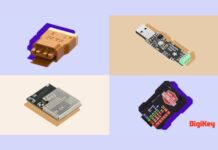CHANDLER, Ariz., December 5, 2018 — Even as touchscreen displays in the car grow larger, drivers expect screens to operate with the same touch experience as mobile phones. However, screens in automobiles need to meet stringent head impact and vibration tests, and consequently have thicker cover lenses that potentially impact the touch interface performance. As screens get larger, they are also more likely to interfere with other frequencies such as AM radio and car access systems. All of these factors become a major challenge in the design of modern automotive capacitive touch systems. A new family of single-chip maXTouch touchscreen controllers from Microchip Technology was designed to address these issues for screens up to 20 inches in size.
The MXT2912TD-A, with nearly 3,000 touch sensing nodes, and MXT2113TD-A, supporting more than 2,000 nodes, bring consumers the touchscreen user experience they expect in vehicles. These new devices build upon Microchip’s existing maXTouch touchscreen technology that is widely adopted by manufacturers worldwide. Microchip’s latest solutions offer superior signal-to-noise capability to address the requirements of thick lenses, even supporting multiple finger touches through thick gloves and in the presence of moisture.
As automakers use screens to replace mechanical switches on the dash for sleeker interior designs, safe and reliable operation becomes even more critical. The MXT2912TD and MXT2113TD devices incorporate self- and sensor-diagnostic functions, which constantly monitor the integrity of the touch system. These smart diagnostic features support the Automotive Safety Integrity Level (ASIL) classification index as defined by the ISO 26262 Functional Safety Specification for Passenger Vehicles.
The new devices feature technology that enables adaptive touch utilizing self-capacitance and mutual-capacitance measurements, so all touches are recognized and false touch detections are avoided. They also feature Microchip’s proprietary new signal shaping technology that significantly lowers emissions to help large touchscreens using maXTouch controllers meet CISPR-25 Level 5 requirements for electromagnetic interference in automobiles. The new touch controllers also meet automotive temperature grade 3 (-40 to +85°C) and grade 2 (-40 to +105°C) operating ranges and are AEC-Q100 qualified.
With the addition of the new maXTouch touchscreen controllers, Microchip provides full scalability to customers, offering the industry’s only complete and growing portfolio of automotive-qualified touchscreen controllers for the use of various screen sizes. Developers can design multiple platforms from small touchpads to large displays in the same development environment with the same host software interface and quality user experience. This ultimately shortens design time while lowering system and development costs.
“Microchip has a long and strong history in the automotive industry. Serving our customers is about more than providing an integrated circuit; it’s about being a partner throughout the very complex supply chain of a touch system, so the display, the sensor and all communications work as expected,” said Fanie Duvenhage, vice president of Microchip’s Human Machine Interface business unit. “The new devices build on this success and address the current trends of increasing screen sizes and reduced finger touch separation in vehicles.”
Development Tools
Eight dedicated application and sensor design centers around the world help Microchip customers and partners accelerate the process of bringing their maXTouch technology designs to market. Microchip’s maXTouch technology specialists are working with all major sensor, display and touch module manufacturers.
An evaluation kit is available for each of the parts in the new maXTouch touchscreen controller family. The kit includes a Printed Circuit Board (PCB) with the maXTouch touchscreen controller, a touch sensor on a clear glass lens, the Flat Printed Circuit (FPC) to connect to the sensor display, a converter PCB to connect the kit to the host computer via USB, as well as cables, software and documentation. All parts are also compatible with maXTouch Studio, a full software development environment to support the evaluation of maXTouch touchscreen controllers.
For more information, visit the Microchip website at www.microchip.com.


















